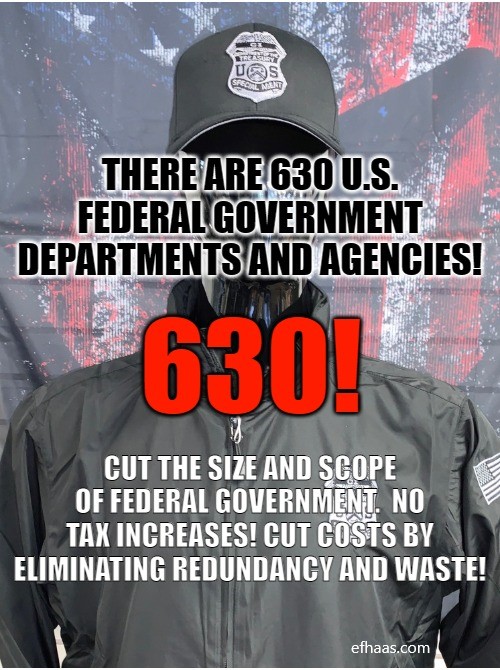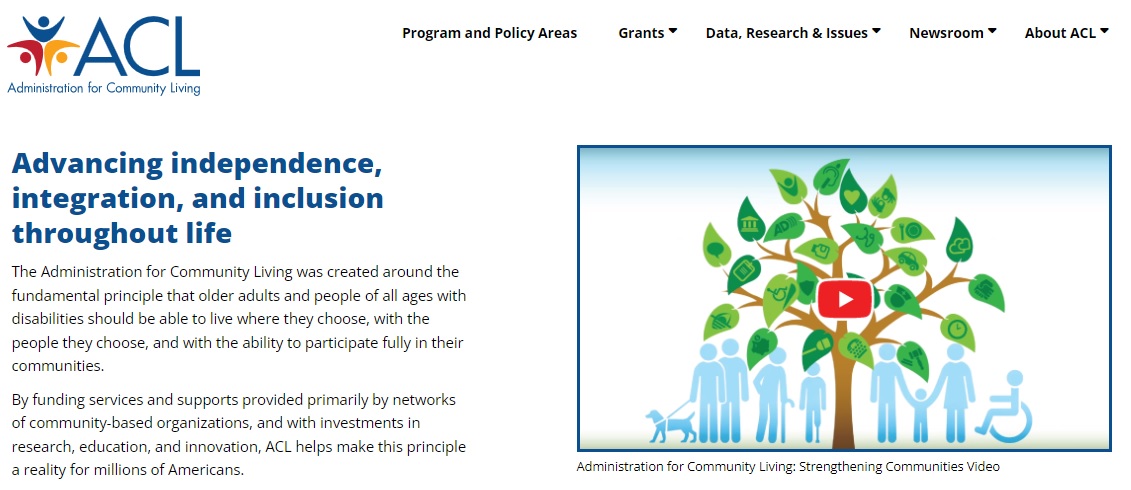Get to Know a Federal Agency – Introducing the Administration for Community Living
There are 630 federal departments, agencies, and commissions. Approximately 400 have regulatory power. Half could be eliminated and most of the nation wouldn’t notice. The loss of liberty and freedom in the United States is proportional to the size and scope of the federal government. The larger the federal government gets; the fewer the rights the 50 states, and the people, retain.
~ E.F. Haas
THE ADMINISTRATION FOR COMMUNITY LIVING
According to its website, The Administration for Community Living (ACL) was created around the fundamental principle that older adults and people of all ages with disabilities should be able to live where they choose, with the people they choose, and with the ability to participate fully in their communities. By funding services and supports provided primarily by networks of community-based organizations, and with investments in research, education, and innovation, ACL helps make this principle a reality for millions of Americans. [1]
Created during the Obama Administration, then Secretary of the Department of Health and Human Services Kathleen Sebelius[2] established the ACL on April 18, 2012. This decision brought together the Administration on Aging, the Office on Disability, and the Administration on Developmental Disabilities.
The Administration for Community Living (ACL) administers programs authorized through a variety of statutes.
Developmental Disabilities Assistance and Bill of Rights Act of 2000 (DD Act)
Older Americans Act (OAA)
Workforce Innovation and Opportunity Act (WIOA)
Christopher and Dana Reeve Paralysis Act
Health Insurance Portability and Accountability Act (HIPAA) of 1996
Medicare Improvements for Patients and Providers Act (MIPPA) of 2008
Omnibus Budget Reconciliation Act (OBRA) of 1990
Supporting Grandparents Raising Grandchildren Act of 2018
TBI Reauthorization Act of 2014
When a federal agency is administrating programs through this many statutes, hope for efficiency is crushed by the weight of redundancy and overstuffed bureaucracy.
3.1 BILLION DOLLAR BUDGET
The Administration for Community Living (ACL) budget for 2023 is $3.1 billion. The administration costs in 2023 for the ACL total $57 million. Nutrition Programs are the largest expense for the ACL, totaling $1.27 billion in 2023. According to the Department of Health and Human Services, Fiscal year 2023 Budget in Brief:
The FY 2023 budget also reflects ACL’s commitment to expanding and improving support to caregivers and to advancing equitable access to healthcare, education, employment, transportation, recreation, and other systems, resources, and opportunities. Finally, the budget funds infrastructure investments to meet the needs of ACL’s growing leadership role on aging and disability policy within the Biden-Harris Administration and Department priorities.[3]
Like every federal government department, agency, administration, and program, “expanding” is the goal. It’s how “purpose” is entrenched and funding ensured. Cutting the size, scope, and budget of a federal agency is to be avoided at all costs. “Growing leadership role” is the top prize! New facilities, additional employees, more power, and bureaucratic prestige are all fruits of expanding and a growing leadership role.
Rooting out redundancy within the federal government should be a high priority considering the level of our national debt. Unfortunately, to tackle and eliminate redundancy would result in the federal government creating another department, 10 agencies, 20 programs, and 50 laws dedicated to eradicating what they, themselves, have become. Nutritional programs and food assistance from the federal government is one of many areas where redundancy is stacked on top of even more redundancy.

FOOD ASSISTANCE
Food assistance at the federal level is everywhere. If hungry, just contact government or private organizations for immediate food assistance:
- Call 211 to find agencies and community organizations that can assist you with finding food in an emergency.
- Call the USDA National Hunger Hotline at 1-866-3-HUNGRY (1-866-348-6479) or 1-877-8-HAMBRE (1-877-842-6273). Information is available in English and Spanish. The hotline operates Monday through Friday, 7:00 AM to 10:00 PM Eastern Time.
The federal government provides SNAP (food stamps), D-SNAP, and WIC for women, infants, and children. It also provides food assistance for school children through:
- The National School Lunch Program
- The School Breakfast Program
- The Special Milk Program, which provides milk for students in schools that do not participate in a federal school meal program
- The Summer Food Service Program offers one or more free meals during summer break. All children and teens 18 or younger qualify. There is no application process and no income limit.
For adults 60 years or older, the USDA offers food assistance through:
- Senior Farmers’ Market Nutrition Program (SFMNP) – Provides coupons for fresh fruits, vegetables, honey, and herbs. You can use the coupons at farmers’ markets, roadside stands, and community farms.
- Commodity Supplemental Food Program (CSFP) – Provides a monthly package of healthy food
Native Americans can get food assistance in additional ways to include the Food Distribution Program on Indian Reservations (FDPIR), which provides monthly packages of healthy food.
All of this assistance is in addition to welfare benefits that can also be used to purchase food, although the recipient of welfare may also be receiving one or more of the other food assistant program benefits.
When we think of food assistance for seniors, the non-profit organization Meals on Wheels likely comes to mind. The Older Americans Act Nutrition Program provides 35% of the federal funding Meals on Wheels receives. The ACL administers programs through the Older Americans Act. Some of the ACL’s $1.27 billion food assistance budget funds organizations such as Meals on Wheels.
REDUNDANCY AND WASTE
The fundamental principle that older adults and people of all ages with disabilities should be able to live where they choose, with the people they choose, and with the ability to participate fully in their communities is noble and just. However, the problem with any assistance from the federal government is it always comes with strings attached. Most often, those strings are attached to political, partisan agendas that are not focused first on good stewardship of the taxpayer’s dollar. Couple this with the millions of Americans employed by the federal government to “administer” these programs and it’s easy to see how built in “waste” is to the entire operation. Now multiply it by twenty to pay for all the redundancy.
It’s not hard to see how much money gets devoured in Washington DC before it leaves an agency office. By the time the “assistance” hits Main Street, USA it’s worth so much less. The federal government doesn’t need more revenue. The federal government needs to cut costs and streamline processes so more money hits the targeted populations, like older adults and people of all ages with disabilities.
Our national debt is $32.6 trillion. We must cut costs. Unpopular and difficult decisions must be made. (4 of 630 in this series)
~ E.F. Haas
[1] The Administration for Community Living (ACL), https://acl.gov/
[2] Kathleen Sebelius, https://ballotpedia.org/Kathleen_Sebelius
[3] Department of Health and Human Services, Fiscal year 2023 Budget in Brief, Page 139, https://www.hhs.gov/sites/default/files/fy-2023-budget-in-brief.pdf




Comments are closed.